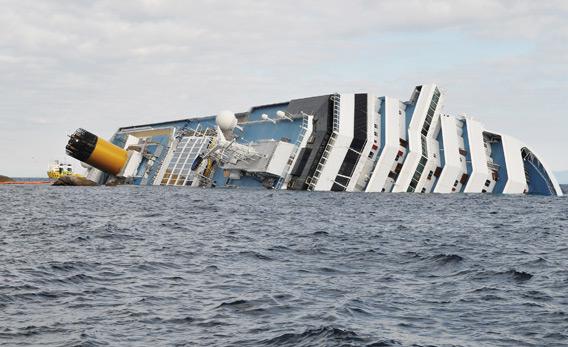The 4,300-passenger cruise ship Costa Concordia ran aground off the Italian coast on Friday. At least 11 people are confirmed dead, and more remain missing. Some passengers say there was chaos during the evacuation, with no respect for the tradition of women and children first. The Italian Coast Guard reportedly ordered the captain, who had abandoned ship, back onto his crippled vessel to assist in the evacuation, but he refused. Are there laws governing how to abandon ship?
Yes, but they say nothing about gender or age. The International Maritime Organization has issued fairly extensive rules about the location and size of lifeboats a cruise ship must offer, and how quickly a company should be able to clear its ship. If an evacuation alarm sounds, cruise-ship passengers are supposed to proceed to the loading area and board a lifeboat that was assigned to them based on their cabin numbers. Some evacuations are far more chaotic than that, and the crew just loads whoever is ready to go. In those emergency situations, men sometimes step aside for the women to go first, but it’s not a matter of maritime law, nor is the tradition observed in many parts of the world. Similarly, the captain has no obligation to go down with the ship, and he or she doesn’t have to be the last person to step into a lifeboat. (In many cases, like the Costa Concordia incident, people go unaccounted for, so requiring the captain to be the last person off would be a death sentence.) Nevertheless, it’s possible that Captain Francesco Schettino failed in his duty to his passengers. The International Convention for the Safety of Life at Sea requires the captain to exercise his professional judgment to protect passenger safety, and most maritime experts would agree that presence on the ship is a prerequisite for fulfilling that obligation. Some nations, such as Italy, Greece, and Spain have laws requiring the captain to remain on the ship to evacuate passengers, although these are rarely enforced and don’t specify exactly when the captain is permitted to leave.*
In her book Women and Children First: 19th-Century Sea Narratives and American Identity, English professor Robin Miskolcze chronicled the origins of our maritime evacuation priorities. Until the second half of the 18th century, it was widely believed in England and America that God decided who would survive a shipwreck, so no one criticized men for climbing over whoever stood between them and safety. However, as Enlightenment thinkers began to emphasize human agency, and women came to be viewed as the holy protectors of the family, news reports grew critical of men who survived shipwrecks that killed female passengers.
Three disasters solidified the principle of women and children first in Britain and America. When the HMS Birkenhead went down in 1852, the soldiers reportedly stood at attention while the women and children were loaded into life boats. The overwhelming majority of the men died in an act that contemporary writers called “a piece of pure and exalted manhood.” Two years later, there was a mad scramble on the decks of the American ship SS Arctic as it foundered near Newfoundland. The press branded the male survivors cowards for failing to save even a single woman or child. American morality was redeemed in 1857, when the crew and male passengers of the SS Central America loaded women and children onto lifeboats at the expense of their own lives. Media reports glorified the gold-rush men who sacrificed their new wealth and their lives in a final act of chivalry. The image of captain William Lewis Herndon calmly smoking a cigar as he went down with his ship became a symbol of American seagoing bravery.
Bonus Explainer: What’s going to happen to the capsized cruise ship? They’ll move it off the reef, very slowly. A salvage company will have to right the Costa Concordia, patch it, and pump out the water before attempting to tow it away. It’s not an easy job under any circumstances, but this will be a particularly tough rescue. Salvagers have to place a bulkhead against the ship to steady it while winches pull it upright. In this case, it will be difficult to find a place to set the bulkhead on the jagged rocks nearby. Air bags might be placed under the hull and inflated to give the ship a boost, but they can’t right the ocean liner on their own. The salvage process will likely take months, and possibly more than a year. If the operation is too difficult, the owners may decide to cut the ship up, take it away on barges, and sell it for scrap.
Got a question about today’s news? Ask the Explainer.
Explainer thanks Lee Adamson of the International Maritime Organization, Mike Lacey of the International Salvage Union, and Robin Miskolcze of Loyola Marymount University.
Correction, Jan. 18, 2012: This article originally omitted information on laws in Italy and other countries that require the captain to remain on the ship to evacuate passengers. (Return to the appended paragraph.)
